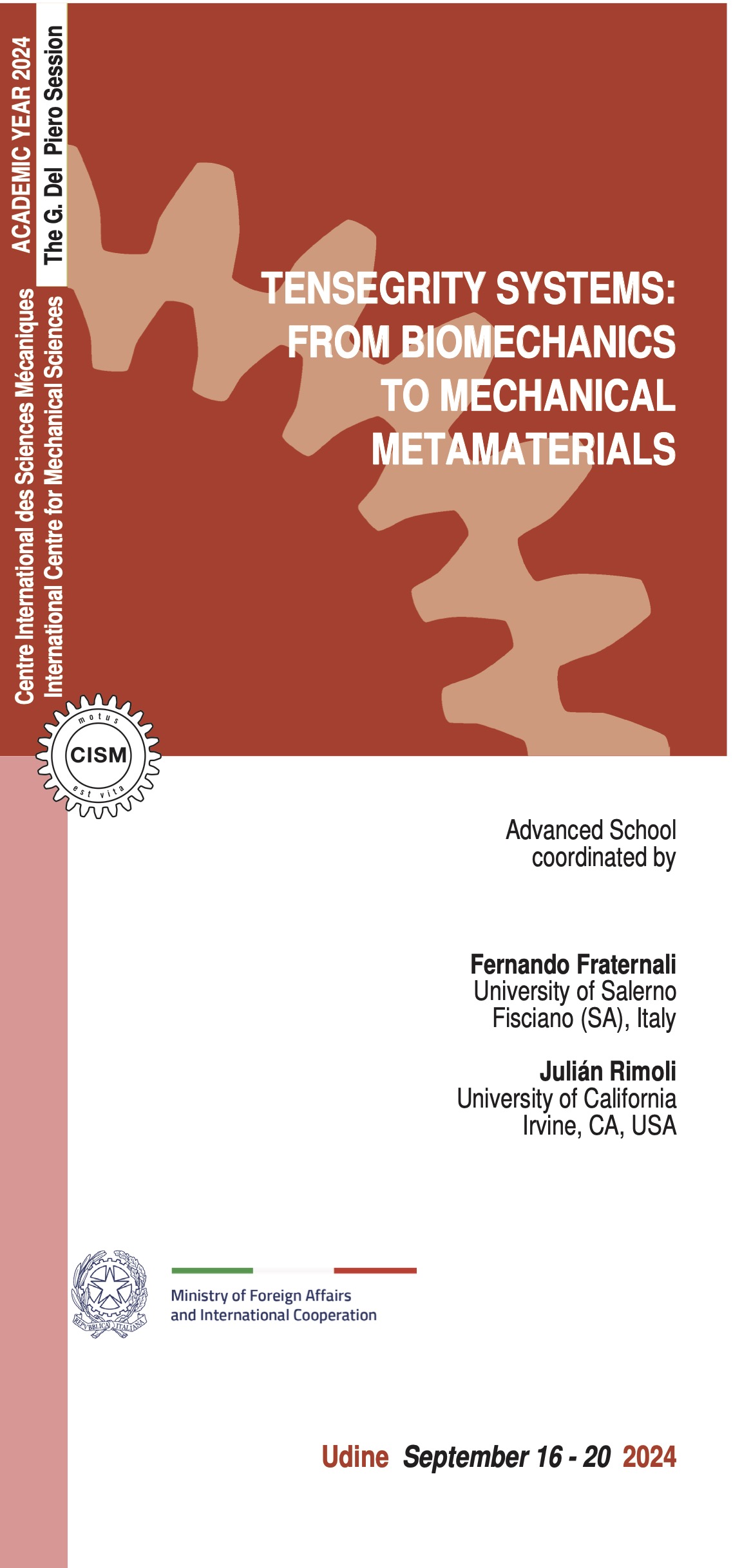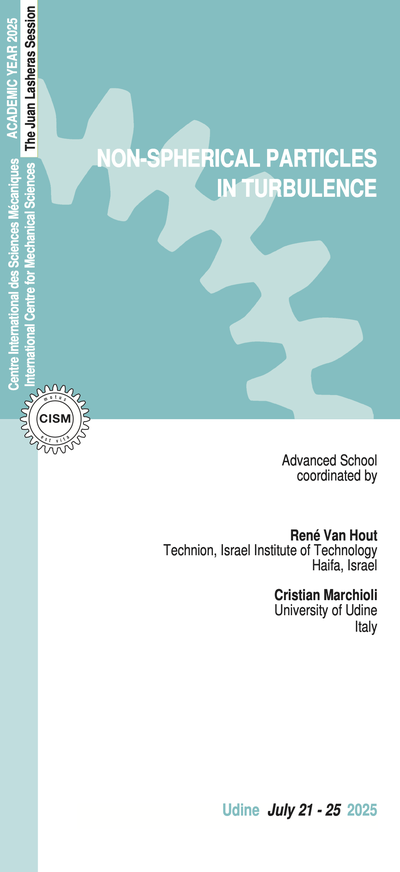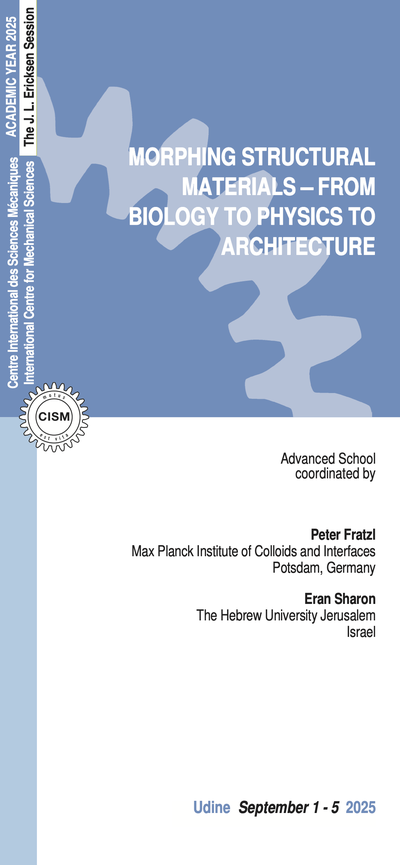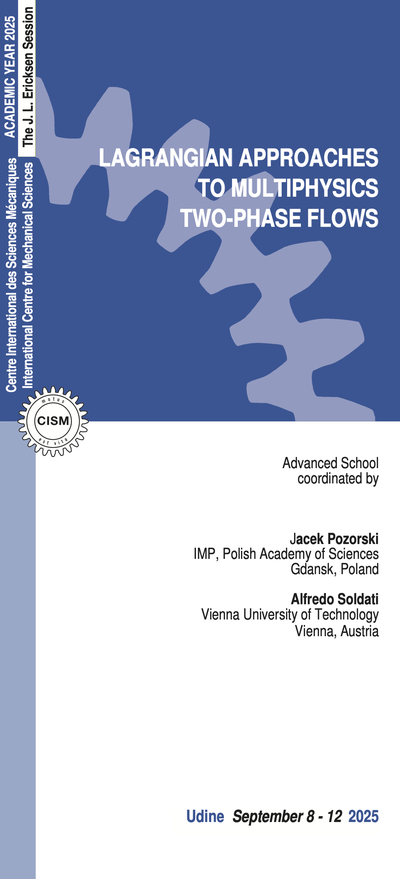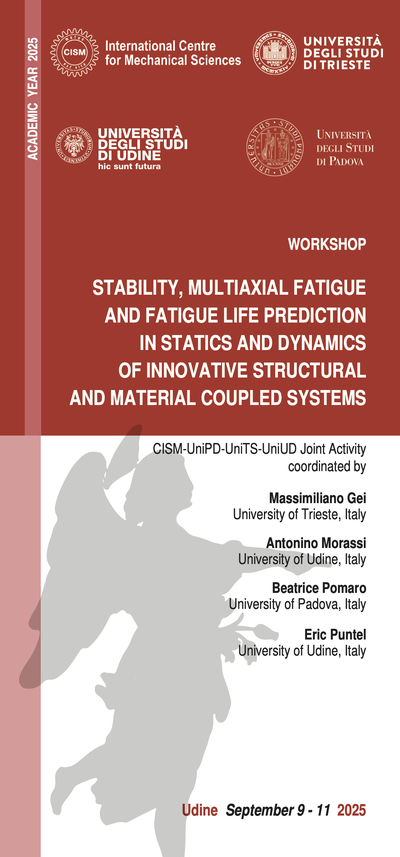Tensegrity structures are prestressable truss structures, obtained by connecting compressive members (bars or struts) through pre-stretched tensile elements (cables or strings). The interest in such structures has been motivated by nature: Tensegrity concepts are ubiquitous and can be found, in every cell, from the microstructure of spider silk to the arrangement of bones and tendons, to name but a few examples. This course is aimed at illustrating the peculiar mechanical behavior of tensegrity systems in the large displacement regime and their application for the development of mechanical metamaterials, space structures, and mechanical models of biological systems.
The course will cover the following thematic blocks:
1. Basic concepts and calculation methods of tensegrity systems: tensegrity principles (classification and case studies), linear theory (force density method, self-stress), stiffness and stability (geometric stiffness, the stress matrix, prestress stability and superstability), form-finding problems and methods, static response, bistable regimes, basic concepts of tensegrity dynamics, tensegrity space structures (case study of a tensegrity ring for a deployable mesh reflector).
2. Tensegrity metamaterials and tensegrity-based mechanical systems: tensegrity metamaterials (basic concepts and casuistry), bandgap response (dispersion relation of tensegrity mass-spring chains, role of prestress), wave dynamics of stiffening-type tensegrity metamaterials (propagation of solitary compression waves), softening-type tensegrity metamaterials (propagation of rarefaction solitary waves), origami tensegrities (deployability, collapsibility and stiffness), seismic protection devices (displacement capacity, superelastic response, energy dissipation properties).
3. Tensegrity structures for space applications and 3D tensegrity metamaterials: post-buckling response of tensegrity planetary landers, 3D tensegrity metamaterials (unique properties in the post-buckling regime), reduced-order models for the dynamic and post-buckling behavior of tensegrity structures, computational implementation (modelling bars and cables, solution techniques for statics and dynamics), advanced Machine Learning (ML) methods for tensegrity.
4. Extremal mechanical properties of tensegrity metamaterials and structures: basic concepts of extremal mechanical properties of materials and structures, tensegrity meta-systems (discrete and continuum models), scale effects (identification of extremal mechanical properties of tensegrity systems in structural scales), 2D and 3D tensegrity modules and lattices with extremal properties.
5. Biotensegrities: overview of biotensegrities (tensegrities mimicking biology systems), biotensegrities mimicking the anatomy and physiology of living organisms, form-finding in the linear regime of self-equilibrated biotensegrities, mathematical modelling of the shape change of biotensegrities (initial, deformed, shape change, and target state), computational approaches and numerical examples.
6. Nonlinear biomechanical character of tensegrity: nonlinear biotensegrities (the role of structure in evolution, triangulation and trusses, non-linearity), soft matter mechanics in living organisms, the fascia connection (ubiquitous of the fascial connections, kinematic chains), muscles mechanics (internal vs external forces), biotensegrity dynamics (instability vs superstability, energy source and storage), mechanics of walking and running in a biotensegrity model. The course is addressed to doctoral students, young researchers, practicing engineers, medical doctors, and architects, interested in tensegrity systems.
This work was supported in part by the Italian Ministry of Foreign Affairs and International Cooperation, grant no. US23GR15.
Micheletti A., 2013. Bistable regimes in an elastic tensegrity system, Proc. R. Soc. A, 27, 20130052.
Amendola, A., Krushynska A., Daraio C., Pugno N.M., Fraternali F., 2018. Tuning frequency band gaps of tensegrity mass-spring chains with local and global prestress, Int J Solids Struct, 155, 47-56.
Micheletti, A., Ruscica, G., Fraternali F. 2019. On the compact wave dynamics of tensegrity beams in multiple dimensions. Nonlin Dyn, 98, 2737–2753.
Fraternali, F., Carpentieri, G., Amendola, A., Skelton, R.E., Nesterenko, V. F., 2014. Multiscale tunability of solitary wave dynamics in tensegrity metamaterials. Appl Phys Lett, 105, 201903.
Bauer, J., Kraus, J. A., Crook, C., Rimoli, J. J., Valdevit, L, 2021. Tensegrity metamaterials: Toward failure-resistant engineering systems through delocalized deformation, Adv Mater, 33(10), 2005647.
Rimoli, J. J., Pal, R. K., 2017. Mechanical response of 3-dimensional tensegrity lattices. Compos B Eng, 115, 30–42.
Al Sabouni-Zawadzka, A., 2022. High Performance Tensegrity-Inspired Metamaterials and Structures. CRC Press.
Gilewski, W. and Al Sabouni-Zawadzka, A., 2020. Equivalent mechanical properties of tensegrity truss structures with self-stress included. Eur J Mech A Solids 83, 103998.
Oh, C.L., Choong, K.K., Nishimura, T., Kim, J.-Y., 2020, Form-finding of spine inspired biotensegrity model. Appl Sci, 10, 6344.
Oh, C.L., Choong, K.K., Nishimura, T., Kim, J.-Y., 2022, Multi-Directional Shape Change Analysis of Biotensegrity Model Mimicking Human Spine Curvature. Appl Sci, 12, 2377.
Levin, S.M., 2002. The tensegrity-truss as a model for spine mechanics: Biotensegrity. J Mech Med Biol, 02(03n04).
Levin, S.M., de Solórzano, S. L., & Scarr, G., 2017. The significance of closed kinematic chains to biological movement and dynamic stability. J Bodyw Mov Ther, 21(3).
6 lectures on: Basic concepts of extremal mechanical properties of materials and structures; Tensegrity meta-systems: discrete and continuum models; Scale effects; 2D tensegrity and 3D tensegrities with extremal properties.
6 lectures on: Tensegrity metamaterials; Bandgap response; Wave dynamics of stiffening-type tensegrity metamaterials; Softening-type tensegrity metamaterials; Origami tensegrities; Seismic protection devices. Superelastic response and energy dissipation properties.
See Julián Rimoli's lectures
6 lectures on: Tensegrity principles; Linear theory; Stiffness and stability (geometric stiffness, the stress matrix, prestress stability and superstability); Form-finding problems and methods; Basic concepts of tensegrity dynamics; Tensegrity space structures.
6 lectures on: Overview of biotensegrities; Biotensegrities mimicking the anatomy and physiology of living organisms; Form-finding of linear biotensegrities; Mathematical modelling of the shape change of biotensegrities; Computational approaches.
Replaced by Kevin Garanger
6 lectures on: Post-buckling response of tensegrity plaanetary landers; 3D tensegrity metamaterials; Reduced-order models; Computational implementation (modeling bars and cables; solution techniques for statics and dynamics); ML methods for tensegrities.
6 lectures on: Nonlinear biotensegrities; Soft matter mechanics in living organisms; The fascia connection; Muscles mechanics; Biotensegrity dynamics (instability vs superstability); Mechanics of walking and running in a biotensegrity model.
ADMISSION AND ACCOMMODATION
The course is offered in a hybrid format, allowing participants the flexibility to attend either in person or remotely via the Microsoft Teams platform.
Limited spots are available for on-site attendance and will be allocated on a first-come, first-served basis.
The registration fees are:
- On-site participation: 600.00 Euro + VAT*
Includes a complimentary bag, five fixed menu buffet lunches, hot beverages, downloadable lecture notes.
Deadline for on-site application is August 16, 2024.
- Live Streaming Online Participation: 250.00 Euro + VAT*
Includes downloadable lecture notes.
Deadline for online application is September 4, 2024.
Application forms should be submitted online through the website: http://www.cism.it.
A confirmation message will be sent to accepted participants.
Upon request, a limited number of on-site participants can be accommodated at CISM Guest House at the price of 35 Euro per person/night (contact: foresteria@cism.it)
* where applicable (bank charges are not included) - Italian VAT is 22%.
CANCELLATION POLICY
Applicants may cancel their registration and receive a full refund by notifying the CISM Secretariat in writing (via email) no later than:
- August 16, 2024 for on-site participants (no refunds after the deadline);
- September 4, 2024 for online participants (no refunds after the deadline).
Cancellation requests received before these deadlines will be subject to a 50.00 Euro handling fee. Incorrect payments are also subject to a 50.00 Euro handling fee.
GRANTS
A limited number of participants from universities and research centres who do not receive support from their own institutions can request a waiver of the registration fee and/or free lodging.
Requests should be sent to the CISM Secretariat (mail to: info@cism.it) by July 16, 2024, along with the applicant's curriculum vitae and a letter of recommendation from the head of the department or a supervisor confirming that the institute cannot provide funding. Preference will be given to applicants from countries that sponsor CISM.
